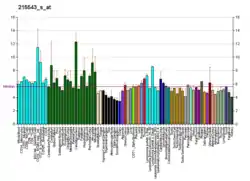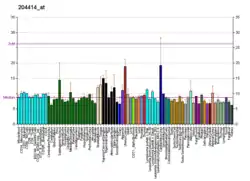LARGE
Glycosyltransferase-like protein LARGE1 is an enzyme that in humans is encoded by the LARGE gene.[5][6][7][8]
Function
This gene, which is one of the largest in the human genome, encodes a member of the N-acetylglucosaminyltransferase gene family. The exact function of LARGE, a golgi protein, remains uncertain.[7] It encodes a glycosyltransferase which participates in glycosylation of alpha-dystroglycan, and may carry out the synthesis of glycoprotein and glycosphingolipid sugar chains. It may also be involved in the addition of a repeated disaccharide unit. Mutations in this gene cause MDC1D, a novel form of congenital muscular dystrophy with severe mental retardation and abnormal glycosylation of alpha-dystroglycan. Alternative splicing of this gene results in two transcript variants that encode the same protein.[7][8]
LARGE may also play a role in tumor-specific genomic rearrangements. Mutations in this gene may be involved in the development and progression of meningioma through modification of ganglioside composition and other glycosylated molecules in tumor cells.
References
- GRCh38: Ensembl release 89: ENSG00000133424 - Ensembl, May 2017
- GRCm38: Ensembl release 89: ENSMUSG00000004383 - Ensembl, May 2017
- "Human PubMed Reference:". National Center for Biotechnology Information, U.S. National Library of Medicine.
- "Mouse PubMed Reference:". National Center for Biotechnology Information, U.S. National Library of Medicine.
- Peyrard M, Seroussi E, Sandberg-Nordqvist AC, Xie YG, Han FY, Fransson I, Collins J, Dunham I, Kost-Alimova M, Imreh S, Dumanski JP (Mar 1999). "The human LARGE gene from 22q12.3-q13.1 is a new, distinct member of the glycosyltransferase gene family". Proc Natl Acad Sci U S A. 96 (2): 598–603. Bibcode:1999PNAS...96..598P. doi:10.1073/pnas.96.2.598. PMC 15182. PMID 9892679.
- Dunham I, Shimizu N, Roe BA, Chissoe S, Hunt AR, Collins JE, Bruskiewich R, Beare DM, Clamp M, Smink LJ, Ainscough R, Almeida JP, Babbage A, Bagguley C, Bailey J, Barlow K, Bates KN, Beasley O, Bird CP, Blakey S, Bridgeman AM, Buck D, Burgess J, Burrill WD, O'Brien KP, et al. (Dec 1999). "The DNA sequence of human chromosome 22". Nature. 402 (6761): 489–95. Bibcode:1999Natur.402..489D. doi:10.1038/990031. PMID 10591208.
- Longman C, Brockington M, Torelli S, Jimenez-Mallebrera C, Kennedy C, Khalil N, Feng L, Saran RK, Voit T, Merlini L, Sewry CA, Brown SC, Muntoni F (Oct 2003). "Mutations in the human LARGE gene cause MDC1D, a novel form of congenital muscular dystrophy with severe mental retardation and abnormal glycosylation of alpha-dystroglycan". Hum Mol Genet. 12 (21): 2853–61. doi:10.1093/hmg/ddg307. PMID 12966029.
- "Entrez Gene: LARGE like-glycosyltransferase".
Further reading
- Nagase T, Ishikawa K, Miyajima N, et al. (1998). "Prediction of the coding sequences of unidentified human genes. IX. The complete sequences of 100 new cDNA clones from brain which can code for large proteins in vitro". DNA Res. 5 (1): 31–9. doi:10.1093/dnares/5.1.31. PMID 9628581.
- Strausberg RL, Feingold EA, Grouse LH, et al. (2003). "Generation and initial analysis of more than 15,000 full-length human and mouse cDNA sequences". Proc. Natl. Acad. Sci. U.S.A. 99 (26): 16899–903. Bibcode:2002PNAS...9916899M. doi:10.1073/pnas.242603899. PMC 139241. PMID 12477932.
- Kanagawa M, Saito F, Kunz S, et al. (2004). "Molecular recognition by LARGE is essential for expression of functional dystroglycan". Cell. 117 (7): 953–64. doi:10.1016/j.cell.2004.06.003. PMID 15210115.
- Collins JE, Wright CL, Edwards CA, et al. (2005). "A genome annotation-driven approach to cloning the human ORFeome". Genome Biol. 5 (10): R84. doi:10.1186/gb-2004-5-10-r84. PMC 545604. PMID 15461802.
- Gerhard DS, Wagner L, Feingold EA, et al. (2004). "The status, quality, and expansion of the NIH full-length cDNA project: the Mammalian Gene Collection (MGC)". Genome Res. 14 (10B): 2121–7. doi:10.1101/gr.2596504. PMC 528928. PMID 15489334.
- Brockington M, Torelli S, Prandini P, et al. (2005). "Localization and functional analysis of the LARGE family of glycosyltransferases: significance for muscular dystrophy". Hum. Mol. Genet. 14 (5): 657–65. doi:10.1093/hmg/ddi062. PMID 15661757.
- Fujimura K, Sawaki H, Sakai T, et al. (2005). "LARGE2 facilitates the maturation of alpha-dystroglycan more effectively than LARGE". Biochem. Biophys. Res. Commun. 329 (3): 1162–71. doi:10.1016/j.bbrc.2005.02.082. PMID 15752776.
- Grewal PK, McLaughlan JM, Moore CJ, et al. (2006). "Characterization of the LARGE family of putative glycosyltransferases associated with dystroglycanopathies". Glycobiology. 15 (10): 912–23. doi:10.1093/glycob/cwi094. PMID 15958417.





